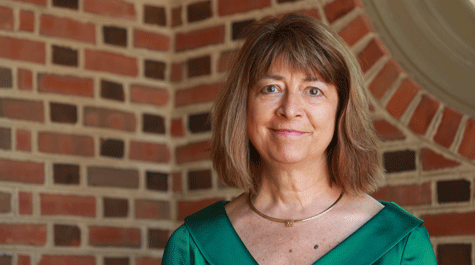A unique view: Stock reflects on time as vice provost at W&M
Ann Marie Stock left the classroom to add her time and talents to the administration at William & Mary. As vice provost for academic & faculty affairs (VPAFA) the past four years, she has had an opportunity to broadly impact teaching and learning.
Stock, a professor of Hispanic studies and film and media studies, brought her own unique perspective to the job.
“She is widely regarded as an outstanding teacher, internationally renowned scholar and successful academic leader,” Provost Peggy Agouris wrote in a campus message.
“Most recently, in her four-year term as vice provost, Ann Marie has consistently demonstrated her creativity, collaborative spirit and commitment to the institution and, in doing so, has brought about significant and lasting changes.”
On April 29, Agouris announced to the campus community Stock’s decision to complete her term as VPAFA at the end of the academic year. The term for VPAFA is usually three years, but Stock stayed on an extra year to provide consistency in leadership during the pandemic. She will take academic leave during the 2021-22 academic year before returning to W&M.
Shortly after the announcement, W&M News asked Stock about her time in the position and her accomplishments.
How did your experience coming into the position allow you to put your own individual mark on it?
I came into the position with nearly a quarter-century of experience at W&M and having had the opportunity to serve in a variety of capacities — teaching as a member of three different programs, serving as department chair and program director, leading international affairs and directing the Reves Center and contributing as inaugural W&M Libraries Faculty Fellow.
All of this shaped my expansive vision of the institution and my awareness of potential synergies and connections. It also provided me with contacts, relationships and friendships in nearly every unit. This W&M-wide perspective and the extensive personal connections positioned me to serve in a range of areas and team up to envision projects, implement ideas and solve problems.
My scholarly training and scholarly approach also served me well. My doctorate is in the field of cultural studies, and I have worked primarily in the intersections — in between languages and cultures and disciplines and world views. I am a seasoned border-crosser, and I think that allowed me to help bring together individuals and units and position them for effective collaboration.
What implementations do you think will be most long-term beneficial?
The Studio for Teaching & Learning Innovation will, I am quite certain, continue to benefit the university for a very long time. I am proud of playing a lead role in bringing that into being, along with collaborators Professor Gene Roche and Dean Carrie Cooper and a team of faculty and learning partners.
I think another area that bears my stamp is the creation of the Cultural Heritage Cluster, consisting of the Muscarelle Museum of Art, Historic Campus, Highland and the Omohundro Institute. By bringing together these units, and by connecting them to the Studio for Teaching & Learning Innovation and the Washington Center, we have been able to design new courses, offer innovative programs and generally take fuller advantage of these incredible resources.
My Advancement colleagues have invited me in to work on fundraising, and I’m confident that the support we've garnered together will continue to be transformational.
How were you able to shape teaching and learning?
One key way was by being a thought partner for individual faculty and groups who would seek me out to brainstorm. I love doing this — particularly when I can put people in touch and facilitate their working together. So I helped shape teaching and learning by empowering, supporting and connecting others so they could realize their vision.
I also led and co-led several initiatives designed to connect faculty with one another to enhance teaching and learning. Among those most special to me are the Reveley Interdisciplinary Faculty Fellows initiative with Luiza Newlin-Lukowicz of Advancement, the Writer's Retreat with Lisa Nickel of W&M Libraries and the soon-to-be launched Grants Incubator with Office of Sponsored Programs, Corporate and Foundation Relations and W&M Libraries.
I've had opportunities to advance the university's ambitious diversity, equity and inclusion agenda.
What is your favorite part of W&M’s vision, mission, values?
“People come to William & Mary wanting to understand and change the world, and together we do.” I feel privileged to be part of a community that strives to build a better future, and I'm grateful to be around so many people who are "all in" in doing this important work.
What was the best part of being vice provost?
I have worked with virtually every unit at W&M, as well as with alumni and board members and donors and community partners. That access to so many people and projects has afforded me an extraordinary learning opportunity and a beautiful bird’s-eye view.
As I transition out of this position, I have a far greater appreciation and understanding of just how complex, complicated and beautiful the W&M world is.
What’s next for you?
That's a great question. I'm thrilled to be looking ahead to some unscheduled time in summer. I'm picturing long walks on gravel roads through the prairies and farmlands in my home state of Minnesota. And a week of canoeing in the Boundary Waters Canoe Area Wilderness.
After that, when Cuba travel is once again possible, I'll be on one of the first planes heading to my beloved Havana where I'll reconnect with friends and renew momentum on my scholarship. I'm eager to expand the Cuba Media Project, a partnership between W&M Libraries and several individuals and organizations on the island.
Beyond that, there are some ideas percolating and some possibilities emerging. But I'm focusing on wrapping up projects on my lengthy vice provost task list and looking ahead to summer.















